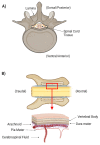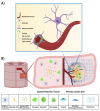Clinical Trials Targeting Secondary Damage after Traumatic Spinal Cord Injury
- PMID: 36835233
- PMCID: PMC9960771
- DOI: 10.3390/ijms24043824
Clinical Trials Targeting Secondary Damage after Traumatic Spinal Cord Injury
Abstract
Spinal cord injury (SCI) often causes loss of sensory and motor function resulting in a significant reduction in quality of life for patients. Currently, no therapies are available that can repair spinal cord tissue. After the primary SCI, an acute inflammatory response induces further tissue damage in a process known as secondary injury. Targeting secondary injury to prevent additional tissue damage during the acute and subacute phases of SCI represents a promising strategy to improve patient outcomes. Here, we review clinical trials of neuroprotective therapeutics expected to mitigate secondary injury, focusing primarily on those in the last decade. The strategies discussed are broadly categorized as acute-phase procedural/surgical interventions, systemically delivered pharmacological agents, and cell-based therapies. In addition, we summarize the potential for combinatorial therapies and considerations.
Keywords: acute and sub-acute strategies; biomaterials; neuroprotective therapies; spinal cord injury repair.
Conflict of interest statement
The authors declare no conflict of interest.
Figures




References
-
- Spinal Cord Injury. [(accessed on 31 July 2022)]. Available online: https://www.who.int/news-room/fact-sheets/detail/spinal-cord-injury.
-
- Spinal Cord Injury Facts and Figures at a Glance 2020 SCI Data Sheet. [(accessed on 1 August 2022)]. Available online: www.msktc.org/sci/model-system-centers.

